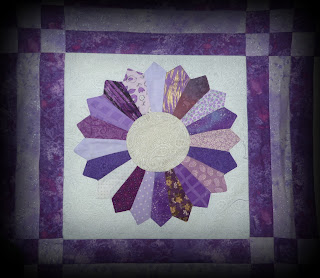 I admit it; I was pretty bummed about my first attempting at spray basting a quilt, detailed in an earlier post.
I admit it; I was pretty bummed about my first attempting at spray basting a quilt, detailed in an earlier post. But that is behind me. What I didn’t reveal, because I only realized it later, is how important it is to read directions. I had no idea I was supposed to finish the bonding process by pressing the piece. Needless to say, my failing to perform that all-important step, resulted in the layers not sticking together. Once I realized my mistake, I was a little bummed. Beyond my own foolishness was the knowledge that I had to spray baste the whole quilt all over again. I knew it would be even be more challenging this time, since I had already quilted an entire motif, right in the center of the quilt that I would have to work around.
I decided that working on the floor was just not an option this time around, so I cleared off the dining room table, put the leaf in it, and set out to flatten out my quilt, upside down. Of course the table wasn’t big enough to accommodate the entire quilt, but I moved it around, folded back some at a time to spray every little nook and cranny, keeping the back as wrinkle-free as possible. Then I pressed it, as it sat on the table. I’m sure that wasn’t good for the table, but a woman has to do what a woman has to do. I made sure I kept the iron moving and it didn’t appear to get too hot three layers down. Once the back was all sprayed and pressed, I worked to secure the quilt top to the bottom fabric and batting which was now one layer since it was stuck together. I walked around that table a gazillion times, folding, smoothing, spraying, smoothing again, and finally pressing. Finally, it was all done. When all else fails, read the directions. So for now, I’m a fan of spray basting. It is so much easier than all those darned safety pins or sewing.
My next challenge is to quilt with or without a hoop. I tried using a large oval hoop, but that was just too cumbersome. Then I dragged out a smaller round one, which was a definite improvement. But, it is actually so much easier to quilt without a hoop at all. Hand quilting got a little easier, once I got the feel of it again. I recently watched Alex Anderson of Simply Quilts and The Quilt Show fame as she spoke about learning to hand quilt. She said to give yourself about 20 hours to get comfortable with hand quilting. I’d say that is about right.
It will be more fun to quilt when it gets cold outside. There is nothing more relaxing than quilting and snuggling all at the same time.



 I tried spray basting a quilt for the first time. Whoa, there has to be a better way. Or, I’m just not doing it right.
I tried spray basting a quilt for the first time. Whoa, there has to be a better way. Or, I’m just not doing it right.


